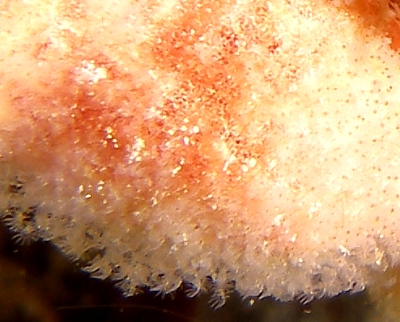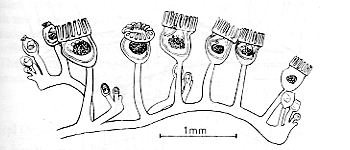

Kamptozoa (Entoprocta)
Phylum: KAMPTOZOA
PHOTO
Upper: Colony of kamptozoans covering part of a sponge. At the bottom, the outstretched feeding tentacles are clearly visible. At the right of the photo the tentacles are out of focus because we are looking down on the zooids. The small brown spots we can see are the food remains in the rectum, near the anal opening. Because of the small size of the zooids, these brown spots are often the only indication in photos of the presence of kamptozoans. Photo: Sean Kearney [see message #19053].
Lower: Part of interlinking colony of Pedicellina. [From: Nielsen, 1964: 54].
These tiny filter-feeding animals belong to the phylum Kamptozoa [or Entoprocta] which includes less than 200 named species. Each individual consists of a goblet shaped body with a stalk to attach it to the substrate or some living object such as an alga or sponge. Around the ‘rim’ of the goblet is an arc of ciliated tentacles, which create a water current and trap organic particles and microscopic organisms which it eats. Both the mouth and the anus are inside this ring of tentacles [Entoprocta = inner anus] which distinguishes them from the Bryozoa [or Ectoprocta] which have the anus opening outside the feeding tentacles. Both phylum are important in opisthobranch biology because they are food items for particular nudibranch groups. The Kamptozoa appear to be the sole prey of the goniodorid nudibrnach genus Trapania. For many years species of Trapania were suspected of feeding on the sponges they are often associated with, but we now know that they feed on species of kamptozoans which associate with the sponges. [If you do a search on the Forum for kamptozoa you will find many messages where examples of this association are described.]
Although kamptozoans can breed sexually, they usually form large colonies of either interlinked zooids or isolated individuals by cloning. Although individual zooids are hard to see with the naked eye, the colonies can often be seen as a ‘fuzz’ over the substrate, or in the case of sponge associates – a fuzz over the surface of the sponge colony, as can be seen in the photo above. Even under a microscope they are hard to see, but a good clue is the dark brown central spot in each ‘goblet’, which is the compacted food remains in the rectum, near the anal opening. Although mostly marine, there are a few freshwater species.
-
Nielsen, C. (1964) Studies on Danish Entoprocta. Ophelia, 1: 1-76.
-
Wasson, K. (2002) A review of the invertebrate Phylum Kamptozoa (Entoprocta) and synopsis of kamptozoan diversity in Australia and New Zealand. Transactions of the Royal Society of South Australia, 126 (1): 1-20.
Rudman, W.B., 2006 (December 21) Kamptozoa (Entoprocta). [In] Sea Slug Forum. Australian Museum, Sydney. Available from http://www.seaslugforum.net/factsheet/kamptozoa
